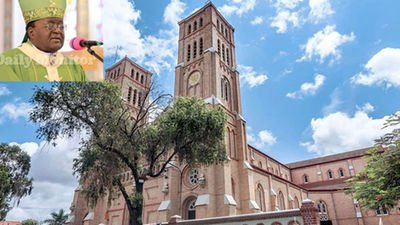By Esther Oluka & Ivan Ssenabulya
The late the Archbishop of the Archdiocese of Kampala, His Grace Dr Cyprian Kizito Lwangawill be laid to rest today.
Archbishop Lwanga died on Saturday and on Monday, a postmortem report revealed that he had succumbed to a heart attack caused by a blood clot.
But unlike many, the Prelate’s final resting place is not outside in a grave yard- It will be inside Rubaga Cathedral, the parent Cathedral of the Roman Catholic Archdiocese of Kampala.
This designated burial location is inside Rubaga Cathedral, on the right-hand side, more precisely, between the graves of Dr. Joseph Kiwanuka and Bishop Edward Michaud.
Dr. Kiwanuka served as the Archbishop of Rubaga from 1961 until the time of his death in 1966, while Bishop Michaud served as the apostolic vicar in Tabora, Tanzania before being transferred to Uganda in 1932. He later died in 1945.
Which leads us to the question- Who is buried inside the Cathedral and why?
According to George William Katende, a guide and receptionist working at Rubaga Cathedral, bishops who die either while in active service or during retirement are buried inside Cathedrals.
He adds that when a deceased bishop, for different reasons, cannot be buried inside the cathedral, a space is then designated for them inside other places of prayer and worship including chapels.
Lwanga served as Bishop of Kasana-Luweero from 1996 to 2006. He later served as the Archbishop of the Archdiocese of Kampala from 2006 until the time of his death.
There are however exceptional cases such as that of the late Cardinal Emmanuel Kiwanuka Nsubuga who stated in his will that he should be buried at the Bakateyamba Home of the elderly and disabled in Nalukolongo near Nateete rather than the Cathedral.
Cardinal Nsubuga was consecrated Archbishop on October 10, 1966 following his appointment by Pope Paul VI.
And, Who is buried in the graves outside Rubaga Cathedral?
Just outside Rubaga Cathedral is another easily noticeable gravesite.
Katende says this is the final resting place for priests who have previously worked in different capacities in the Catholic Church including Rubaga Cathedral.
“When they die, they are not usually taken back to their ancestral home but rather, laid to rest in a cemetery or in a location near or attached to the Cathedral,”
He says “That is the tradition of the Catholic Church and the same has been done for the Popes over the years.
Most extant papal tombs are located in St. Peter’s Basilica, other major churches of Rome or other churches of Italy, France, and Germany.
It’s also an opportunity to display to the world what has become a tourist attraction under the Vatican: the body of John XXIII, perfectly preserved since his death in 1963, entombed in a glass coffin. The pope’s body is the most prominent example of a four-decade experiment by the Church to sustain its holy relics.
Fare thee well Archbishop Cyprian Kizito Lwanga.








